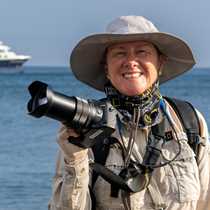Floreana Island
It was clear! It was blue! The sky for the first time in many months was visible on waking up while anchored off Post Office Bay, northern Floreana. I thought perhaps it was the true beginning of the warm, wet season, until I took the water temperature later. On reaching Champion Islet after breakfast, it was 68 degrees Fahrenheit and definitely not the hot season yet. While circumnavigating the islet we dangled our toes in the water and felt the chill. But it did not deter many, because the clarity seemed ideal for snorkeling.
However before even entering the water, we searched out and spotted several of the endemic and endangered Charles (or “Floreana”) mockingbirds. In one particular picture-perfect scene, the mockingbird sat atop an Opuntia megasperma var. megasperma, considered an endemic and vulnerable species, excavating the prickly pear flower. The blossoms of the cacti were magnificent and showy, an orange hue overlaying the traditional yellow.
We saw a frigatebird kleptoparasitize a red-billed tropicbird, causing the regurgitated fish to fall from the tropicbird and become lost in the guano-covered rocks of a sea-lion haul-out. The long white tails of the tropicbirds made them easy to spot along the low bluffs of Champion, as many of them sat rumps out, feathers blowing lightly in the breeze..
On entering the water it was immediately apparent that the clarity seen from above was not going to be part of our experience while snorkeling. The reason there were hundreds of king angelfish, dusky chubs, razor surgeonfish and Creole fish massed at the surface was because they were feeding on microscopic particulate matter. It appeared to be newly spawned eggs or larvae, however we never could find the source. Some clouds were later identified as miniscule fish fry.
To reinforce the idea that the warm, wet season had not yet set upon us, over mid-day the clouds came in the sank low, draping us in a fine mist that at first discouraged the kayakers, but which later dissipated.
The afternoon walk surprised everyone with the presence of a flamingo sleeping on the bank of the lagoon, in the company of three white-cheek pintail ducks (also sleeping). The ever-present sea lions slept also, on our landing beach; and to finish it off, a female green sea turtle was found sleeping on the white beach on the other side of the point. Needless to say we took the hint and returned on board as the sun set.
It was clear! It was blue! The sky for the first time in many months was visible on waking up while anchored off Post Office Bay, northern Floreana. I thought perhaps it was the true beginning of the warm, wet season, until I took the water temperature later. On reaching Champion Islet after breakfast, it was 68 degrees Fahrenheit and definitely not the hot season yet. While circumnavigating the islet we dangled our toes in the water and felt the chill. But it did not deter many, because the clarity seemed ideal for snorkeling.
However before even entering the water, we searched out and spotted several of the endemic and endangered Charles (or “Floreana”) mockingbirds. In one particular picture-perfect scene, the mockingbird sat atop an Opuntia megasperma var. megasperma, considered an endemic and vulnerable species, excavating the prickly pear flower. The blossoms of the cacti were magnificent and showy, an orange hue overlaying the traditional yellow.
We saw a frigatebird kleptoparasitize a red-billed tropicbird, causing the regurgitated fish to fall from the tropicbird and become lost in the guano-covered rocks of a sea-lion haul-out. The long white tails of the tropicbirds made them easy to spot along the low bluffs of Champion, as many of them sat rumps out, feathers blowing lightly in the breeze..
On entering the water it was immediately apparent that the clarity seen from above was not going to be part of our experience while snorkeling. The reason there were hundreds of king angelfish, dusky chubs, razor surgeonfish and Creole fish massed at the surface was because they were feeding on microscopic particulate matter. It appeared to be newly spawned eggs or larvae, however we never could find the source. Some clouds were later identified as miniscule fish fry.
To reinforce the idea that the warm, wet season had not yet set upon us, over mid-day the clouds came in the sank low, draping us in a fine mist that at first discouraged the kayakers, but which later dissipated.
The afternoon walk surprised everyone with the presence of a flamingo sleeping on the bank of the lagoon, in the company of three white-cheek pintail ducks (also sleeping). The ever-present sea lions slept also, on our landing beach; and to finish it off, a female green sea turtle was found sleeping on the white beach on the other side of the point. Needless to say we took the hint and returned on board as the sun set.




